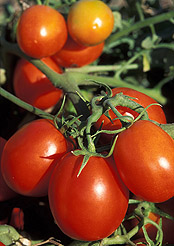Tomato Cannery Tackles Tough Water-Reuse Issues
Freshly harvested fruits and vegetables, packed into cans, glass jars, or aseptic packs, are convenient and nutritious.
But America’s canneries—as well as juice-processing plants and wineries—need lots of clean, fresh water to wash and process field, orchard, and vineyard harvests.
What to do with all that water after it’s been used for these jobs is becoming a monumental problem for many food processors nationwide. Strict environmental regulations make some of yesterday’s disposal choices no longer an option.
Agricultural Research Service salinity experts at the George E. Brown, Jr., U.S. Salinity Laboratory in Riverside, California, have jumped in to help develop economical, Earth-friendly ways to manage the used water. Three soil scientists—Don Suarez and Pete Shouse, with ARS, and Scott Lesch, with the University of California-Riverside—have teamed with the Sacramento-based California League of Food Processors to apply the best science-based water-management practices to solving processors’ water-reuse problems.
Right now, they’re determining how a major California cannery might get more value from wash water that’s left after processing plump, field-fresh tomatoes. The cannery uses the wastewater to irrigate forage that’s fed to beef cattle.
The Riverside salinity team is an apt choice for the project: The factory uses a form of salt—sodium hydroxide or potassium hydroxide—to loosen tomatoes from their tightly attached skins. Some of that salt of course ends up in the wastewater.
As one way to add value to the wastewater, Suarez hopes to eventually replace today’s forage crop with higher value alfalfa for feeding to dairy cattle.
The scientists have already used the lab’s own technology—known as “electromagnetic salinity profiling”—and its accompanying software package to map the salinity levels of the wastewater-irrigated fields. From analyzing the maps, they’ve determined the best sites for taking the soil-chemistry samples needed to determine levels of other potential troublemakers—like boron—that could leach into the underground water supply,
“We’ve found several spots that have a sodium adsorption ratio, or SAR, of higher than 15,” says Shouse. “Our experience has been that crop production is likely to be only marginal, at best, on sites with a SAR of 15 or higher.”
Some areas have a hard, sodic crust on the soil surface. “It’s difficult for seeds to sprout through that crust,” Shouse says. What’s more, the crust impedes infiltration, making it tricky for irrigation water to reach plant roots. These areas of the field can be made productive by making management changes, such as adding gypsum or other soil amendments.
“We’re also looking at how often and how uniformly water is applied,” says Suarez. Irrigating more often—without overwatering the plants—can help prevent the soil from drying and cracking, he says. Cracks can serve as direct channels to groundwater and can thus exacerbate unwanted leaching.
“Improved irrigation uniformity,” he explains, “ensures that equal amounts of water are going to all areas of the field. It helps to prevent leaching, increases crop yields, and avoids wasting water. Improving infiltration rates in the sodic portions of the field will also increase uniformity of water infiltration across the field.
“These aren’t new ideas,” Suarez points out, “but the water-reuse collaboration with the League is new and is a first for ARS.
“We want to demonstrate that instead of being a disposal burden and a liability, the used water is really an asset—a valuable resource.”—By Marcia Wood, Agricultural Research Service Information Staff.
This research is part of Water Availability and Watershed Management, an ARS national program (#211) described on the World Wide Web at www.nps.ars.usda.gov.
Donald L. Suarez and Peter J. Shouse are with the USDA-ARS George E. Brown, Jr., U.S. Salinity Laboratory, 450 W. Big Springs Rd., Riverside, CA 92501; phone (951) 369-4815 (Suarez), (951) 369-4849 (Shouse), fax (951) 342-4960.
"Tomato Cannery Tackles Tough Water-Reuse Issues" was published in the January 2009 issue of Agricultural Research magazine.







